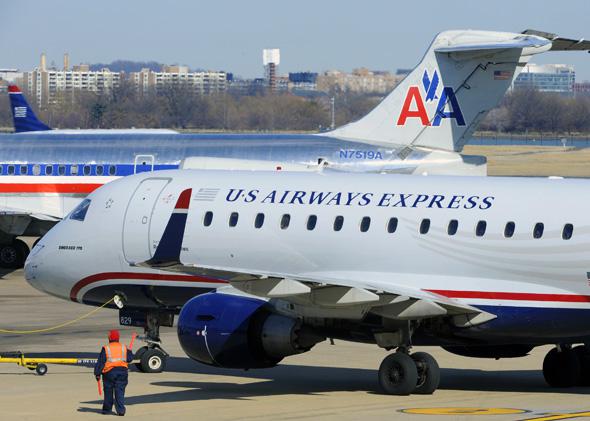American Airlines is announcing its quarterly earning results on Thursday. Most likely, they’ll post another quarter of profits following success in recent quarters in turning around the bankrupt company. Ordinarily, that would be cause for celebration. There’s more to life than quarterly profits, of course, but workers and managers at established businesses normally like the idea of profitability—except at American Airlines, where good financial results may do more harm than good.
That’s because American is trying to put itself out of business by merging with US Airways. But the Justice Department doesn’t want to let it, arguing that the merger will reduce competition and harm consumers. American’s strongest counterargument would be to show that it’s not viable as an independent company—an argument that strong quarterly earning results would badly undercut.
Rumblings of a merger began almost as soon as American filed for bankruptcy protection in November 2011. The aviation industry had, for quite some time, been in a cycle of consolidation. America West purchased the old US Airways and adopted its brand. Delta absorbed Northwest. United swallowed Continental. Southwest gobbled AirTran. Time and again, airlines managed to reduce excess costs and improve profitability by growing larger in scale. A bigger airline can serve the same population as two smaller airlines with fewer total flights and somewhat less extensive hub operations, and strengthen its financial position.
American’s CEO and a few other top executives stood to reap a huge payday if they managed to emerge from bankruptcy and only later discuss mergers, but American’s workforce preferred to merge as soon as possible. US Airways—considerably smaller than United, Delta, or Southwest but cash-rich enough to swallow American—was the logical partner. And so American’s unions did something a bit unusual and began preemptively negotiating hypothetical labor agreements with US Airways executives. Post-merger integration of separate collective bargaining agreements has frequently been a problem with airline tie-ups, and bankrupt companies generally want concessions from unions. Labor’s willingness to get these issues straightened out in advance of a merger became a major inducement to merge. Then labor started pressing American’s creditors.
Soon enough, the creditors and US Airways management reached a deal. The plan was to form a new airline that, in deference to American’s larger size, would retain American Airlines’ name and branding. Top management would be current US Airways executives, but the new airline would belong to the American’s OneWorld alliance (with British Airways and Cathay Pacific) rather than US Airways’ Star Alliance (with Lufthansa and Air China).
Politically speaking, it looked like a done deal. Here was an iconic American company that, in principle, could have vanished from the Earth—its airplanes and landing slots auctioned off to pay old debts—and cost the country thousands of jobs. Instead, a new owner was riding to the rescue with the support of the workforce at the troubled firm. What could be better?
But the Justice Department’s Antitrust Division felt otherwise, and filed an injunction to stop the merger.
US Airways and American, it turns out, made the exact same mistake as AT&T and T-Mobile when they tried to merge. A deal with union backing sounds nice, and in purely political terms it is nice. But the Antitrust Division genuinely makes these calls on the merits, and as far as antitrust analysis goes, labor support is actually a huge red flag.
Regulators generally assume that when companies merge, they do so for some kind of sound, profit-increasing business reason. This assumption may actually be wrong. CEOs of larger firms get paid more than smaller ones, but firms that announce acquisitions normally see their share price drop. It’s at least possible that many mergers represent foolish empire-building on the part of executives that has nothing to do with business. But regulators start with the assumption that managers know what they’re doing. And from a competition perspective, the benign answer to the question “Why will this merger help you make money?” is “Combining the companies will let me lay off lots of now-redundant workers.” If workers are excited about a merger, then that means higher profit margins are probably coming in the form of higher prices—which generally means reduced competition.
There’s little doubt that this merger would reduce competition, removing an option on over 1,600 connecting routes around the country. That’s going to mean higher prices for customers, reversing a decades-long trend toward more competition.
When the merger was first announced, my view was that the public should accept it as inevitable. Competition and low prices are great, but you can’t have so much competition that the companies all go out of business. One case for blocking the AT&T/T-Mobile merger was that there were clearly other merger partners available, such as Sprint and Metro PCS; the AT&T angle was the most lucrative one for T-Mobile’s owners, but the worst one for consumers. American is different. Merging with US Airways would reduce competition, but merging with United or Delta or Southwest would be much worse. And the company was, after all, bankrupt and clearly not likely to survive.
That’s certainly the strongest legal argument the company can present at the trial starting in November. But the past two quarters worth of profits have cast doubt on the veracity of the American-was-doomed-anyway argument. Another good earning result this week would further undermine the case and strengthen the Justice Department’s view that American should be forced to stay independent. Strong profits would be good news for travelers, but bad news for the company itself.
